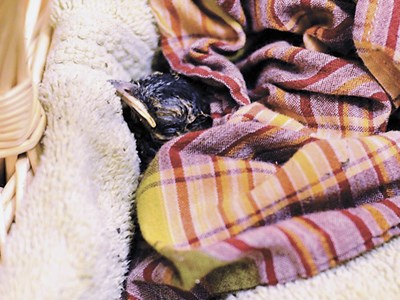It started with the soccer ball escaping down the hill towards the wood pile. Or maybe it began with the neighbour calling to complain about that precarious branch.
Or perhaps it was when the arborists arrived and sawed off the offending limb. Whatever it was and however it began, the long and short of it is this: we are the proud family of a thriving baby robin.
My partner’s son, Orson, found him struggling in a pile of wood at the base of the aborist’s chipper. His soccer ball had escaped him and it rolled directly to the struggling creature.
A bloody demise averted, we took him in and, using the old robin’s nest found a year before in the cedar out back, set him up cozily.
The previous week, I had rescued a grackle from the roadside and this bird, named Blackerton posthumously, had not lasted 24 hours.
In my experience, a young bird who has undergone a trauma will not last long, but our goal was humble: we should provide it a measure of comfort in its dying hours. So the nest was rigged up and hung in a basket.
Surely this featherless creature would rest beside Blackerton; it was only a matter of time. And so we waited.
Orson had lately become interested in birds, and arrived at our home from the great city of Toronto equipped with feeders, guide books, binoculars and a keen interest. His knowledge of “what to do in an emergency bird situation” was sharp and so we let him take charge.
He collected enough worms from the garden that soon enough, the bird was quieted and fell to sleep on a full stomach.
Having calmed a dire situation, our thoughts turned to Orson’s new feeders. A trip to the Backyard Birder was arranged, and we arrived with our list.
Orson asked about the likely fate of the robin and the reply was that there was a chance the parents would be keen on finding their lost offspring, and to return it to the base of the tree out of which it tumbled.
We quickly paid and sped home. We returned the bird to the tree and almost immediately, the parents returned and began feeding it. We sat opposite, and with the binoculars, took turns marveling that the parents would not abandon their young after the involvement of humans.
The nest was in an old mitten basket and was lined with washcloths. Surely this was taken as a sign of solidarity amongst beasts. We were on the same team, as it were. All parties wanted that bird to thrive.
That evening, a great storm blew in, shaking the timbers and clapping thunderously. We decided to check in on the bird.
Perhaps it was the dark, or the wild wind and rain, or it could have been the featherless quivering — whatever it was, we returned home with the nest, knowing full well it would not make it through the storm.
We gently removed the shaking bird, replacing the sopping wet cloths for a heating pad and a soft cloth.
Orson suggested we commit to a name, figuring he might be around for a while. We decided on Robin Wood, of the Wembley Street Maples.
Look for the second part of Robin’s story in next week’s Northern Life.
Anne Boulton is an avid gardener who lives in Sudbury. Visit her blog at greenboots.ca or contact her at [email protected].
Posted by Vivian Scinto
Join Sudbury.com+
- Messages
- Post a Listing
- Your Listings
- Your Profile
- Your Subscriptions
- Your Likes
- Your Business
- Support Local News
- Payment History
Sudbury.com+ members
Already a +member?
Not a +member?
Sign up for a Sudbury.com+ account for instant access to upcoming contests, local offers, auctions and so much more.
